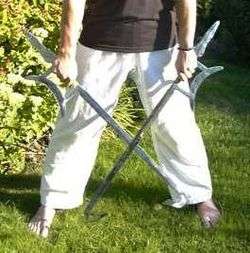Hook sword

The hook sword, twin hooks, fu tao, hu tou gou (tiger head hook) or shuang gou (simplified Chinese: 钩; traditional Chinese: 鈎 or 鉤; pinyin: Gou) is a Chinese weapon traditionally associated with northern styles of Chinese martial arts and Wushu weapons routines, but now often practiced by southern styles as well.
Background
Reliable information on hook swords is difficult to come by. While sometimes called an ancient weapon and described as dating from the Song dynasty to Warring States or even earlier, most antique examples and artistic depictions are from the late Qing era or later, suggesting that they are actually a comparatively recent design. They were also an exclusively civilian weapon, appearing in none of the official listings of Chinese armaments. Surviving sharpened examples point to actual use as weapons, but their rarity, and the training necessary to use them, strongly suggest that they were only rarely used as such.
Characteristics
Also known as "tiger hook swords" or qian kun ri yue dao (literally "Heaven and Earth, Sun and Moon sword"[1]), these weapons have a blade similar to that of the jian, though possibly thicker or unsharpened, with a prong or hook (similar to a shepherd's crook) near the tip. Guards are substantial, in the style of butterfly swords. Often used in pairs, the hooks of the weapons may be used to trap or deflect other weapons.
There are five components to the hook sword:
- The back, which is used as a regular sword.
- The hook, which is used to trip enemies, catch weapons and for slashing.
- The end of the hilt, which is sharpened.
- The crescent guard, which is used for blocking and slashing.
- The link, which is used when using a pair. The two hooks can loosely connect, and the wielder swings one hook sword, in a way that the second is extended further out, almost six feet. While the second is in the air, the dagger upon the hilt slashes the target. In this way, the wielder can extend their reach out from three feet to six.
Use
Routines for hook swords are taught in such northern schools as Northern Shaolin and Seven-Star Mantis, and in some schools of southern arts such as Choy Lay Fut. Modern routines for hook swords are often very flashy, and may involve techniques such as linking paired weapons and wielding them as a single long, flexible weapon. Most routines are single person. Some schools of Baguazhang also teach a similar weapon, often called "deer horn knives" or "Mandarin duck knives." These weapons typically feature a much shorter or entirely missing main hook, and instead focus on the various cutting and stabbing blades arranged around the guard. Because of the various protrusions and the high possibility for accidental hooking or stabbing, they are almost never used in sparring, and are used sparingly in two person routines.
In popular culture
- In the popular animated television series Avatar: The Last Airbender, the Earth Kingdom rebel Jet utilizes a pair of hook swords.
- In the movie The One Armed Swordsman, the villain Long-Armed Devil and his men use hook swords with a mechanically enhanced hook.
- In the duel between Shulien (Michelle Yeoh) and Jen Yu (Zhang Ziyi) in the movie Crouching Tiger, Hidden Dragon, Shulien uses a number of traditional Chinese weapons in turn, one of which is a pair of hook swords. The other weapons she uses are the four major weapons of Chinese martial culture: the single-edged sword or dao; the spear or qiang; the hard whip; and the double-edged straight sword or jian. She also picks up but does not manage to use a monk's spade or yuèyáchǎn.
- In the Mortal Kombat series of video games, Kabal, Mavado and Erron Black use hook swords
- In the anime adaptation of the popular manga series, Bleach, the anime-only character Shusuke Amagai's released zanpakuto takes the form of a hook sword, with the hook facing the opposite direction it normally does.
- In Dynasty Warriors 8, Yue Jin wields the twin hookswords as his signature weapon.
- In Shadow Fight 2, the twin hookswords, referred as shuang gou, are an unlockable weapon. There is a ceremonial version easter egg.
- In Infinity Blade 2, Twin hookswords can be found as a usable weapon.
- Martial artist and actress Cynthia Rothrock says hook swords are her preferred weapons.[2]
- Perhaps the earliest cinematic display of the Twin Hook swords, comes from Eddie Murphy's 1986 movie, Golden Child, where he encounters one of the evil henchmen in a restaurant that has a pair of the swords.
See also
References
- ↑ "Chinese Martial Art Weapons - Ken To Fude No Ryu Kenshu Kai Karate - Hanshi Solly Said". Kenfuderyu.co.za. Retrieved 2013-05-05.
- ↑ "Cynthia Rothrock Episode". A3U Podcast.com. A3U Podcast.com. Retrieved 2008-02-18.
- Kennedy, Brian; Elizabeth Guo (2005). Chinese Martial Arts Training Manuals: A Historical Survey. Berkeley, California: North Atlantic Books. ISBN 1-55643-557-6.
- Lee, Kam Wing (1985). The Secret of Seven-Star Mantis Style. Hong Kong: Lee Kam Wing Martial Art Sports Association.